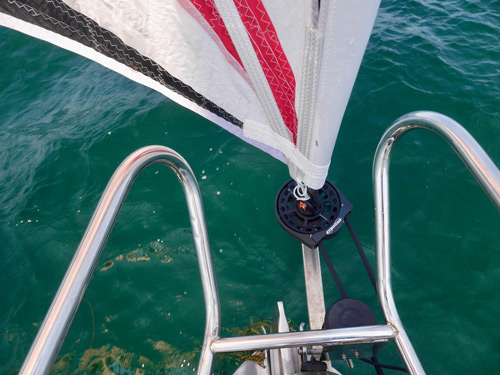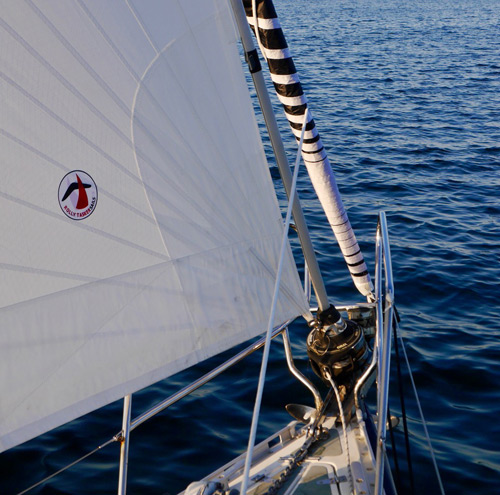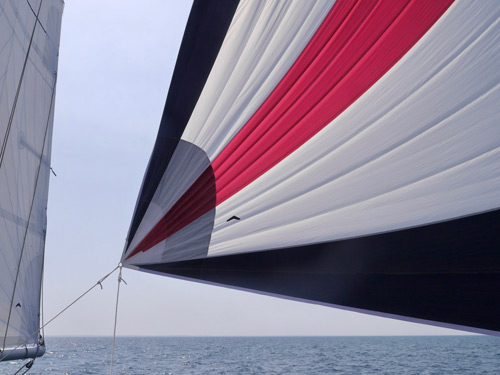The Code C sail was developed by Rolly Tasker Sails specifically for cruising sailors, hence the “C” – which means maximum ease of handling and drive without any consideration for rating rules. This sail could possibly be described as a cross between a very light (reaching) Genoa and an asymmetric spinnaker: It really is that versatile! The sail can be flown on all reaching courses from 65 to 135 degrees off the wind and can even be poled out like a Genoa when running dead downwind. The sail is best for light to medium winds.
FITTING A SHORT BOWSPRIT
To get the best out of the sail it is set on a specially made furler (can be supplied by us) with a continuous line. The Code C sail needs to be set in front of and clear of the forestay or furling Genoa and ideally also clear of the pulpit. On some boats where the forestay attachment is actually a little way inside from the bow, this presents no problem at all. Other yachts sometimes already have a short bow platform for the anchor and for stepping ashore easier when moored bow-to, in this case you will need to check of the platform is stout enough and supported to carry the loads of the Code C sail should you set it from there.

Many yachts however have their forestays attached in the bows and will need a short bowsprit from which the Code C can then be set. This can either be a moveable pole (can be bought off the shelf in most chandleries and the round fittings for it are easily bolted to the deck), or an easily made fixed pole as can be seen in the photos here. Which solution will work best for your boat is of course individual, but in most cases easier to fit than thought at first glance. In any case, the Code C should be set at least about 40 or 50 centimetres out in front of the forestay.
Mainly among ocean-going blue water cruising folk. This divides the headsail area into two more manageable sails and gives more flexibility. If the wind increases, the “Yankee”, as the forward and larger of the two cutter-rig headsails is often called, can simply be rolled away and the boat can sail on under main and cutter jib only.
SETTING THE FURLED SAIL
The Code C can be pre-set before leaving the marina for a pleasant day-sail. It needs to be set up quite tight, with enough luff tension to stop it from sagging into the forestay and also to ensure smooth furling. When setting the sail, the clew will be tied around the furled sail and this tier will then need to be replaced by the sheets. Make sure that the sail is furled tight and the sheets are tensioned to keep it that way before leaving harbour! This works well in light to medium winds, but is not recommended in stronger winds when the top part of the sail could partially unfurl. Another consideration is the added windage and turbulence immediately in front of the luff of the jib or Genoa that is caused by the furled and set Code C sail, but for cruising this will probably be accepted for the ease of handling the pre-set sail. When bearing off, just furl in the jib and unfurl the Code C and off you go! It really is that easy.
FURLING THE CODE C
When furling the Code C, it helps (as it also does when furling a Genoa or jib) to bear off in order to minimise pressure in the sail. It can be furled much easier, with less flogging and also much neater, when it is kept in the lee of the mainsail. If the sail is furled while it still has too much pressure, the furl will not be neat. Due to the shape and the nature of the sail, the foot will then be furled extremely tight, with the top half being furled only loosely which can even result in having a flapping part of the sail up top even when the foot is tightly furled. In that case either bear off, unfurl and try again – or take the sail down on deck to avoid damage.
BARBER HAULER
The Code C sail is designed so that it is very easy and uncomplicated to trim. However, as mentioned before, the luff needs to be set up tight. On some courses, especially closer reaches, it will pay or become necessary to also put more tension on the leech of the sail, to give it more power and to stop flapping in the top part. To achieve this, an easily rigged up Barber hauler is the best solution. Just clip a snatch block onto the sheet, with a line attached to it that runs through another block on the foot railing or on deck and tighten this until the sail once more show its best shape.






